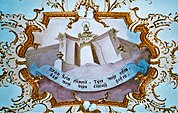Christian eschatology is a minor branch of study within Christian theology which deals with the doctrine of the "last things", especially the Second Coming of Christ, or Parousia. Eschatology – the word derives from two Greek roots meaning "last" (ἔσχατος) and "study" (-λογία) – involves the study of "end things", whether of the end of an individual life, of the end of the age, of the end of the world, or of the nature of the Kingdom of God. Broadly speaking, Christian eschatology focuses on the ultimate destiny of individual souls and of the entire created order, based primarily upon biblical texts within the Old and New Testaments.

A pearl is a hard, glistening object produced within the soft tissue of a living shelled mollusk or another animal, such as fossil conulariids. Just like the shell of a mollusk, a pearl is composed of calcium carbonate in minute crystalline form, which has deposited in concentric layers. The ideal pearl is perfectly round and smooth, but many other shapes, known as baroque pearls, can occur. The finest quality of natural pearls have been highly valued as gemstones and objects of beauty for many centuries. Because of this, pearl has become a metaphor for something rare, fine, admirable and valuable.

Welsh rarebit or Welsh rabbit is a dish of hot cheese sauce served on toasted bread. The original 18th-century name of the dish was the jocular "Welsh rabbit", which was later reinterpreted as "rarebit", as the dish contains no rabbit. Variants include English rabbit, Scotch rabbit, buck rabbit, golden buck, and blushing bunny.

Pearl is a late 14th-century Middle English poem that is considered one of the most important surviving Middle English works. With elements of medieval allegory and from the dream vision genre, the poem is written in a North-West Midlands variety of Middle English and is highly—though not consistently—alliterative; there is, among other stylistic features, a complex system of stanza-linking.
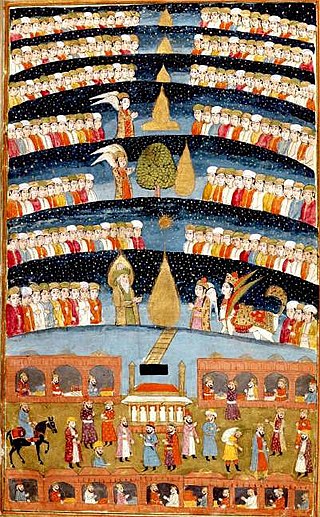
In Islam, Jannah is the final abode of the righteous. According to one count, the word appears 147 times in the Qur'an. Belief in the afterlife is one of the six articles of faith in Sunni and Twelver Shi'ism and is a place in which "believers" (Mumin) will enjoy pleasure, while the unbelievers (Kafir) will suffer in Jahannam. Both Jannah and Jahannam are believed to have several levels. In the case of Jannah, the higher levels are more desirable, and in the case of Jahannam, the lower levels have a higher level of punishments. — in Jannah the higher the prestige and pleasure, in Jahannam the severity of the suffering. The afterlife experiences are described as physical, psychic and spiritual.

In the Book of Ezekiel in the Hebrew Bible, New Jerusalem is Ezekiel's prophetic vision of a city centered on the rebuilt Holy Temple, the Third Temple, to be established in Jerusalem, which would be the capital of the Messianic Kingdom, the meeting place of the twelve tribes of Israel, during the Messianic era. The prophecy is recorded by Ezekiel as having been received on Yom Kippur of the year 3372 of the Hebrew calendar.

Nammalvar was one of the twelve Alvar saints of Tamil Nadu, India, who are known for their affiliation to the Vaishnava tradition of Hinduism. The verses of the Alvars are compiled as the Naalayira Divya Prabandham, where praises are sung of 108 temples that are classified as divine realms, called the Divya Desams. Nammalvar is considered to be the fifth in the line of the twelve Alvars. He is highly regarded as a great mystic of the Vaishnava tradition. He is also considered to be the foremost among the twelve Alvars, and his contributions amount to 1352 among the 4000 stanzas in the Naalayira Divya Prabandam.
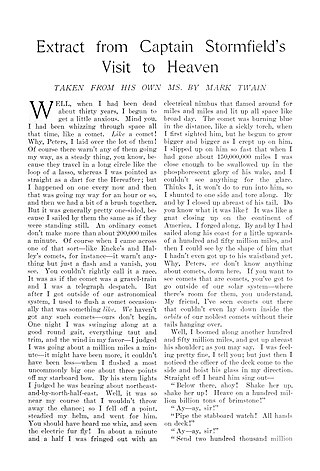
"Extract from Captain Stormfield's Visit to Heaven" is a short story written by American writer Mark Twain. It first appeared in print in Harper's Magazine in December 1907 and January 1908, and was published in book form with some revisions in 1909. This was the last story published by Twain during his life.
The Book of Gates is an ancient Egyptian funerary text dating from the New Kingdom. The Book of Gates is long and detailed, consisting of one hundred scenes. It narrates the passage of a newly deceased soul into the next world journeying with of the sun god, Ra, through the underworld during the hours of the night towards his resurrection. The soul is required to pass through a series of 'gates' at each hour of the journey. Each gate is guarded by a different serpent deity that is associated with a different goddess. It is important that the deceased knows the names of each guardian. Depictions of the judgment of the dead are shown in the last three hours. The text implies that some people will pass through unharmed, but others will suffer torment in a lake of fire. At the end of Ra's journey through the underworld, he emerges anew to take his place back in the sky.

The Wish List is a fantasy novel by Irish writer Eoin Colfer. It chronicles the adventures of Meg Finn, a teenage girl killed in a gas explosion who must earn her place in Heaven by returning to Earth to help the pensioner she attempted to rob.
Papal coats of arms are the personal coat of arms of popes of the Catholic Church. These have been a tradition since the Late Middle Ages, and has displayed his own, initially that of his family, and thus not unique to himself alone, but in some cases composed by him with symbols referring to his past or his aspirations. This personal coat of arms coexists with that of the Holy See.

The Acts of Peter and the Twelve or the Acts of Peter and the Twelve Apostles is a Christian text from about the 4th century. It is the first treatise in Codex VI of the Nag Hammadi library texts, taking up pages 1–12 of the codex's 78 pages. The writing extends the Parable of the Pearl from Matthew 13:45–46. In the text, Peter the Apostle meets a pearl merchant named Lithargoel, who is later revealed to be Jesus. Jesus commands the apostles to care for the poor.

The primacy of Peter, also known as Petrine primacy, is the position of preeminence that is attributed to Peter among the Twelve Apostles.
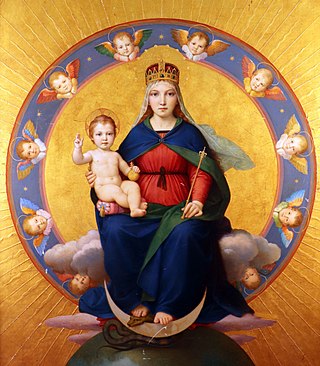
The Woman of the Apocalypse is a figure–often considered to be a reference to the Virgin Mary in Catholic theology–described in Chapter 12 of the Book of Revelation.
Shamayim is the dwelling place of God and other heavenly beings according to the Bible. It is one of three components of the biblical cosmology. There are two other ones. Eretz (Earth), home of the living, and sheol, the realm of the dead—including, according to post Hebrew-Bible literature, the abode of the righteous dead.

Heaven's Gate was an American new religious movement known primarily for the mass suicides committed by its members in 1997. Commonly designated a cult, it was founded in 1974 and led by Bonnie Nettles (1927–1985) and Marshall Applewhite (1931–1997), known within the movement as Ti and Do, respectively. Nettles and Applewhite first met in 1972 and went on a journey of spiritual discovery, identifying themselves as the two witnesses of Revelation, attracting a following of several hundred people in the mid-1970s. In 1976, a core group of a few dozen members stopped recruiting and instituted a monastic lifestyle.

Saint Peter, also known as Peter the Apostle, Simon Peter, Simeon, Simon, or Cephas, was one of the Twelve Apostles of Jesus Christ and one of the first leaders of the early Christian Church. He appears repeatedly and prominently in all four New Testament gospels as well as the Acts of the Apostles. Catholic tradition accredits Peter as the first bishop of Rome—or pope—and also as the first bishop of Antioch.

In Christianity, the term Five Discourses of Matthew refers to five specific discourses by Jesus within the Gospel of Matthew.
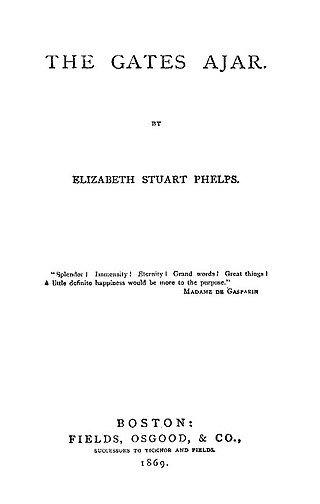
The Gates Ajar is an 1868 religious novel by Elizabeth Stuart Phelps that was immensely popular following its publication. It was the second best-selling religious novel of the 19th century. 80,000 copies were sold in America by 1900; 100,000 were sold in England during the same time period. Sequels Beyond the Gates (1883) and The Gates Between (1887) were also bestsellers, and the three together are referred to as the author's "Spiritualist novels."
Amu-Aa or, is one of the gods that goes with Osiris during the second hour of the night.

